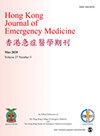Prediction rule of supratherapeutic peak serum salicylate level in poisoning patients attending emergency departments
IF 0.8
4区 医学
Q4 EMERGENCY MEDICINE
引用次数: 0
Abstract
Analgesic poisoning is common in Hong Kong. Analgesics containing salicylate are easily available. Salicylate poisoning may be encountered in the daily practice of the accident and emergency department. The issue of routine salicylate screening was discussed in a number of articles, and the viewpoints of most authors were that routine salicylate screening was unnecessary. The primary outcome is to explore the predictive factors of supratherapeutic peak serum salicylate level (>2.17 mmol/L) and delineate the role of routine screening serum salicylate level in poisoned patients attending the accident and emergency department. This is a retrospective cohort study. Poisoning cases presented to Hong Kong Poison Information Centre between 1 July 2008 and 31 October 2020 with serum salicylate level checked were included. The demographics, laboratory parameters and clinical outcomes were reviewed. There were 8673 cases included with serum salicylate level checked, accounting for 17% of all poisoning cases. Sixty-six (0.76%) cases had supratherapeutic peak serum salicylate level and 11 (0.13%) of them were undeclared salicylate ingestion. Worse clinical outcomes were observed in cases with supratherapeutic peak serum salicylate level. Univariate analysis showed that tinnitus, hyperthermia, alkalaemia, metabolic acidosis, respiratory alkalosis and therapeutic use of aspirin were significantly associated with supratherapeutic peak serum salicylate level. Variables with p < 0.3 were entered into the backward stepwise logistic regression by likelihood ratio. A clinical prediction rule with three attributes (tinnitus, therapeutic use of aspirin and partial pressure of CO2 <5 kPa) was derived. It showed 100% sensitivity in internal validation. Serum salicylate level should be checked in poisoned patients with (1) tinnitus, (2) the therapeutic use of aspirin or (3) partial pressure of CO2 <5 kPa in arterial or venous blood gas. Routine salicylate screening remained a tool for clinicians not experienced in toxicology.急诊科中毒患者血清水杨酸超治疗峰值水平的预测规律
止痛剂中毒在香港很常见。含有水杨酸的镇痛药很容易获得。在急诊科的日常工作中可能会遇到水杨酸中毒。许多文章讨论了常规水杨酸筛查的问题,大多数作者认为常规水杨酸筛查是不必要的。主要目的是探讨血清水杨酸水平治疗超峰值(>2.17 mmol/L)的预测因素,并描述常规筛查血清水杨酸水平在急诊科中毒患者中的作用。这是一项回顾性队列研究。包括在2008年7月1日至2020年10月31日期间向香港毒物信息中心提交的中毒病例,并检查了血清水杨酸水平。回顾了人口统计学、实验室参数和临床结果。检查水杨酸水平8673例,占全部中毒病例的17%。66例(0.76%)患者血清水杨酸水平高于治疗峰值,11例(0.13%)患者未申报水杨酸摄入。在血清水杨酸水平达到治疗峰值的病例中观察到较差的临床结果。单因素分析显示,耳鸣、高热、碱血症、代谢性酸中毒、呼吸性碱中毒和治疗性使用阿司匹林与治疗性峰值血清水杨酸水平显著相关。采用似然比法将p < 0.3的变量输入后向逐步logistic回归。导出了具有耳鸣、阿司匹林治疗性使用和CO2分压<5 kPa三个属性的临床预测规则。内部验证灵敏度为100%。中毒患者应检查血清水杨酸水平(1)耳鸣,(2)治疗使用阿司匹林或(3)动脉血或静脉血气体CO2分压<5 kPa。常规水杨酸筛查仍然是临床医生没有毒理学经验的工具。
本文章由计算机程序翻译,如有差异,请以英文原文为准。
求助全文
约1分钟内获得全文
求助全文
来源期刊

Hong Kong Journal of Emergency Medicine
EMERGENCY MEDICINE-
CiteScore
1.50
自引率
16.70%
发文量
26
审稿时长
6-12 weeks
期刊介绍:
The Hong Kong Journal of Emergency Medicine is a peer-reviewed, open access journal which focusses on all aspects of clinical practice and emergency medicine research in the hospital and pre-hospital setting.
 求助内容:
求助内容: 应助结果提醒方式:
应助结果提醒方式:


